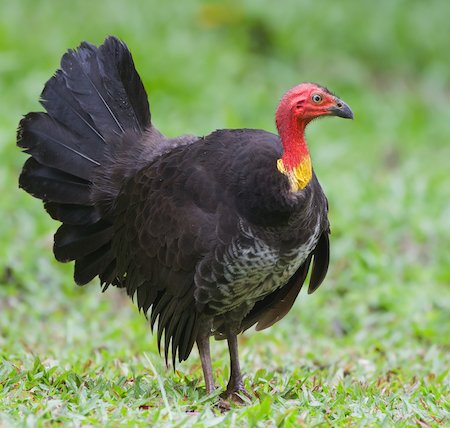Megapodiidae – Megapodes

The family known as Megapodiidae or megapodes are also known as incubator birds or mound-builders. They are are stocky, medium-large chicken-like birds with small heads and large feet. Their name literally translates from the Greek as ‘large foot’ and is a reference to the heavy legs and feet typical of these terrestrial birds. All are browsers, and all but the malleefowl occupy wooded habitats. Most are brown or black coloured. Megapodes are super-precocial, hatching from their eggs in the most mature condition of any birds. They hatch with open eyes, bodily coordination and strength, full wing feathers and downy body feathers, and are able to run, pursue prey, and, in some species, fly on the same day they hatch.
They are medium-sized to large terrestrial birds with large legs and feet with sharp claws. They range from 28cm to 70cm. The largest members of the clade are the species of Alectura and Talegalla. The smallest are the Micronesian Scrubfowl Megapodius laperouse and the Moluccan Scrubfowl Eulipoa wallacei. They have small heads, short beaks, and rounded and large wings. Their flying abilities vary within the clade. They present the hallux at the same level of the other toes just like the species of the clade Cracidae. The other Galliformes have their halluces raised above the level of the front toes.
They are found in the broader Australasian region, including islands in the western Pacific, Australia, New Guinea, and the islands of Indonesia east of the Wallace Line, but also the Andaman and Nicobar Islands in the Bay of Bengal. The distribution of the family has contracted in the Pacific with the arrival of humans, and a number of island groups such as Fiji, Tonga, and New Caledonia have lost many or all of their species.
Megapodes are mainly solitary birds that do not incubate their eggs with their body heat as other birds do, but bury them. Their eggs are unusual in having a large yolk, making up 50–70% of the egg weight. The birds are best known for building massive nest-mounds of decaying vegetation, which the male attends, adding or removing litter to regulate the internal heat while the eggs hatch. However, some bury their eggs in other ways; there are burrow-nesters which use geothermal heat, and others which simply rely on the heat of the sun warming sand. Some species vary their incubation strategy depending on the local environment. Although the Australian Brush Turkey was thought to exhibit temperature-dependent sex determination, this was later proven false; temperature does, however, affect embryo mortality and resulting offspring sex ratios. The non-social nature of their incubation raises questions as to how the hatchlings come to recognise other members of their species, which is due to imprinting in other members of the order Galliformes. Recent research suggests an instinctive visual recognition of specific movement patterns is made by the individual species of megapode.
Megapode chicks do not have an egg tooth; they use their powerful claws to break out of the egg, and then tunnel their way up to the surface of the mound, lying on their backs and scratching at the sand and vegetable matter. Similar to other superprecocial birds, they hatch fully feathered and active, already able to fly and live independently from their parents.
Eggs previously assigned to Genyornis have been reassigned to giant megapode species. A lot of the dietary and chronological data previously assigned to dromornithids may instead be consigned to the giant megapodes.
According to the IOC there are 21 species in this family, which are:
Australian Brushturkey Alectura lathami
Wattled Brushturkey Aepypodius arfakianus
Waigeo Brushturkey Aepypodius bruijnii
Red-billed Brushturkey Talegalla cuvieri
Black-billed Brushturkey Talegalla fuscirostris
Collared Brushturkey Talegalla jobiensis
Malleefowl Leipoa ocellata
Maleo Macrocephalon maleo
Moluccan Megapode Eulipoa wallacei
Tongan Megapode Megapodius pritchardii
Micronesian Megapode Megapodius laperouse
Nicobar Megapode Megapodius nicobariensis
Philippine Megapode Megapodius cumingii
Sula Megapode Megapodius bernsteinii
Tanimbar Megapode Megapodius tenimberensis
Dusky Megapode Megapodius freycinet
Biak Megapode Megapodius geelvinkianus
Melanesian Megapode Megapodius eremita
Vanuatu Megapode Megapodius layardi
New Guinea Megapode Megapodius decollatus
Scrubfowl Megapodius reinwardt
-
Australian Brush Turkey Alectura lathami
Species AccountThe Australian Brush-turkey has a mainly black body plumage, bare red head, yellow throat wattle (pale blue in northern birds) and laterally flattened tail. The Australian Brush-turkey is not easily confused with any other Australian bird. It is the largest of Australia's three megapodes (Family Megapodiidae). The megapodes are a distinct family of the group of fowl-like birds (Order Galliformes), which includes quails, turkeys, peafowl and junglefowl. -
Australian Brush Turkey Alectura lathami
Species AccountSound archive and distribution map. -
Australian Brush Turkey Alectura lathami
Species AccountThe Australian brushturkey or Australian brush-turkey (Alectura lathami), also frequently called the scrub turkey or bush turkey, is a common, widespread species of mound-building bird from the family Megapodiidae found in eastern Australia from Far North Queensland to Illawarra in New South Wales.
-
Number of bird species: 21
